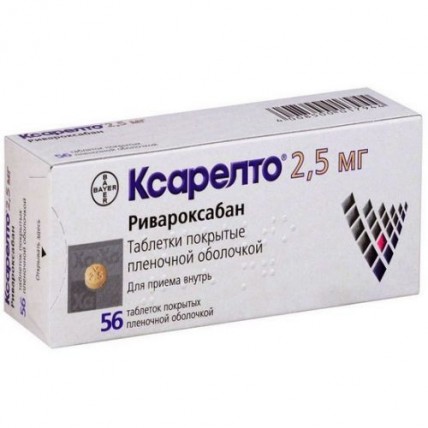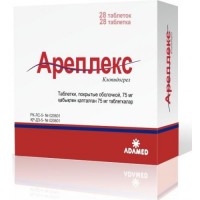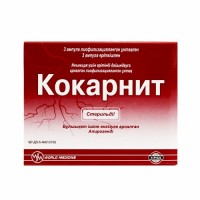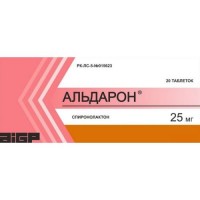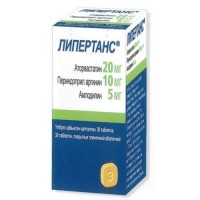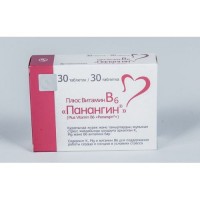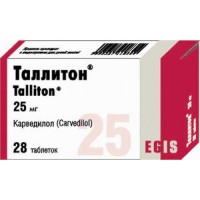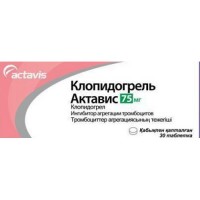Xarelto ® 56's 2.5 mg film-coated tablets
- $185.20
The instruction for medical use of Xarelto ®â medicine This medicine is subject to additional monitoring. It will allow to reveal new information on safety quickly. We appeal to health care providers to report about any suspected undesirable reactions. A trade name of Xarelto ®â the International unlicensed name Rivaroksaban Lekarstvennaya the Tablet form, film coated, 2.5 mg Structure One tablet contains active agent - rivaroksaban micronized 2.5 mg, excipients: microcrystalline cellulose, sodium of a kroskarmelloz, gipromelloz 5 sr (hydroksipropilmetiltsellyuloza of 2910), lactoses monohydrate, magnesium stearate, sodium lauryl sulfate, structure of a cover: gland (ІІІ) oxide yellow (E172), gipromelloza 5 sr (hydroksipropilmetiltsellyuloza of 2910), macrogoal 3350 (polyethyleneglycol (3350)), titan dioxide (E171). The description of the Tablet of round shape, with a biconvex surface, film coated light yellow color, with a triangle and marking 2.5 on one party and a signature bayerovsky cross on other party. Pharmacotherapeutic Blood group and hemopoiesis. Antitrombotichesky drugs. Direct inhibitors of a factor Ha. Rivaroksaban. The ATX B01AF01 code the Pharmacological Rivaroksaban Pharmacokinetics Absorption properties is quickly soaked up, the maximum concentration (Smaks.) are reached in 2-4 hours after reception of a tablet. After intake absorption of a rivaroksaban almost full, and bioavailability after reception of a dose of 2.5 mg high (80-100%), irrespective of meal. Meal does not influence AUC (the area under a curve concentration – time) or Smaks (maximum concentration) of a rivaroksaban of 2.5 mg. A pill rivaroksaban 2.5 mg can be taken irrespective of meal. The pharmacokinetics of a rivaroksaban has almost linear character at reception of doses to 15 mg once a day. At higher doses the absorption of a rivaroksaban limited to dissolution and decrease in bioavailability in process of increase of a dose of drug is noted. These changes are more significant on an empty stomach, than at meal. The pharmacokinetics of a rivaroksaban is characterized by moderate individual variability (variation coefficient, %) within 30–40%. Absorption of a rivaroksaban depends on the place of release of drug in digestive tract. It is necessary to avoid introduction of a rivaroksaban more distally than a stomach as it can lead to decrease in absorption and as a result – to decrease in exposure of a rivaroksaban. Distribution In a human body the most part of a rivaroksaban (92-95%) contacts seralbumin – the main connecting component. Distribution volume – average, Vss is about 50 l. Metabolism and removal Rivaroksaban is removed mainly in the form of metabolites (about 2/3 from the accepted dose) – with urine and a stake in identical ratios. Other third of the accepted dose is removed with kidneys in not changed look, mainly by active renal secretion. Metabolism of a rivaroksaban is carried out by means of the system of CYP3A4, CYP2J2 cytochrome and the mechanisms not dependent on this system. The main sites of biotransformation are the morfolinonovy group which is exposed to oxidizing degradation and hydrolyzable amide bridges. Rivaroksaban is substrate for proteins carriers: R-gp (glycoprotein P) and Bcrp (protein of resistance of a breast cancer). Not changed rivaroksaban is the most important connection in human plasma which does not have the significant or active circulating metabolites in plasma. Rivaroksaban whose system clearance is about 10 l/h can be carried to medicinal substances with low clearance. After intravenous administration of a rivaroksaban of 1 mg the elimination half-life makes about 4.5 hours. After oral administration the removal becomes dependent on absorption speed. At removal of a rivaroksaban from plasma the terminal elimination half-life makes 5–9 hours at young faces and 11–13 hours at older persons. A gender Of men and women of clinically significant distinctions of pharmacokinetics and a pharmacodynamics it is not revealed. Advanced age At elderly patients of concentration of a rivaroksaban in plasma is higher, than at young patients, average AUC is about 1.5 times more, than at young patients, mainly, owing to reduced general and renal clearance. Dose adjustment is not required. Various weight categories Too small or big weight (less than 50 kg and more than 120 kg) only slightly affects concentration of a rivaroksaban in plasma (less than 25%). Dose adjustment is not required. Ethnic distinctions of Clinically significant distinctions of pharmacokinetics and a pharmacodynamics at patients of Caucasian, African-American, Latin American, Japanese or Chinese ethnic origin it was not observed. The liver failure At patients with cirrhosis and a slight liver failure (class A on Chayld-Pyyu) pharmacokinetics of a rivaroksaban differs slightly that is expressed by increase in AUC of a rivaroksaban on average by 1.2 times. For patients with cirrhosis with a moderate liver failure (class B on Chayld-Pyyu) average AUC considerably increased by 2.3 times, and free AUC – in 2.6. At these patients the decrease in renal removal of a rivaroksaban similar to patients to a moderate renal failure is also noted. Data for patients with a heavy liver failure are absent. Patients with a moderate liver failure were more sensitive to a rivaroksaban that was expressed in higher pharmacokinetic and pharmakodinamichesky interrelation between concentration of a rivaroksaban in plasma and a prothrombin time. Rivaroksaban is contraindicated to patients with the liver diseases which are followed by a coagulopathy and risk of clinically significant bleeding including patients with cirrhosis of class B and C on Chayld-Pyyu. The renal failure At patients with a renal failure is observed the increase in exposure of a rivaroksaban correlating with decrease in the renal function estimated on clearance of creatinine. At patients with easy (clearance of creatinine of 50-80 ml/min.), moderated (clearance of creatinine of 30-49 ml/min.) or heavy (clearance of creatinine of 15-29 ml/min.) the renal failure observed 1.4-, 1.5- and 1.6-fold increase in concentration of a rivaroksaban in plasma (AUC), respectively. The corresponding increase in pharmakodinamichesky effects was more expressed. At patients with a slight, moderate and heavy renal failure the general suppression of activity Ha of a factor increased in 1,5, 1,9 and 2 times, respectively, at the corresponding lengthening of a prothrombin time in 1,3, 2,2 and 2.4 times, respectively. Given at patients with clearance of creatinine & lt, 15 ml/min. are absent. Owing to high linking with proteins of plasma of removal of a rivaroksaban against the background of dialysis it is not expected. It is not recommended to use drug at patients with clearance of creatinine & lt, 15 ml/min. It is necessary to be careful at use of Xarelto ® for patients with clearance of creatinine of 15-29 ml/min. Pharmacokinetic data at patients At the patients accepting rivaroksaban 2.5 mg two times a day for prevention of aterotrombotichesky events after a sharp coronary syndrome, average geometrical concentration (90% a predictive interval) in 2-4 hours and about 12 hours after administration of drug (the maximum and minimum concentration which are approximately calculated during reception) made 47 (13-123) and 9.2 (4.4-18) mkg/l, respectively. Pharmacokinetic and pharmakodinamichesky interactions at patients Assessment of interrelation of pharmacokinetics and a pharmacodynamics between concentration of a rivaroksaban in blood plasma and several FD indicators (inhibition Ha of a factor, the prothrombin time (PT), the activated partial tromboplastinovy time (APTT), Heptest) was estimated after purpose of wide range of doses of 5-30 mg 2 times a day. Communication between concentration of a rivaroksaban and activity Ha of a factor is in the best way described by the Emaks model. Concerning PV the linear model of pieces describes data in the best degree. Depending on the used reagent for definition of PV, the curve bias considerably differs. When using Neoplastin PT reagent initial PV made about 13 seconds, and the bias made 3-4 seconds / (100 mkg of l). A pharmacodynamics the action Mechanism Rivaroksaban – the high-selection direct inhibitor Ha a factor having high bioavailability at oral administration. The inhibition of Xa of a factor interrupts internal and external ways of a cascade of fibrillation that leads both formation of thrombin, and forming of blood clots to suppression. Rivaroksaban does not inhibit thrombin (the activated II factor) and does not influence thrombocytes. Pharmakodinamichesky effects At the person the dose-dependent inhibition of activity Ha of a factor is observed. Rivaroksaban has dose-dependent impact on the prothrombin time which is closely correlating with concentration in plasma when using Neoplastin® reagent. When using other reagents the results can differ. The Prothrombin Time (PT) should be defined in seconds as INR (the international normalized relation) is calibrated and validirovano only for coumarins and it cannot be applied to other anticoagulants. During treatment rivaroksabany carrying out routine monitoring of parameters of fibrillation is not required. However at the clinical indication the level of a rivaroksaban can be determined by means of the calibrated quantitative activity test against Ha factor. Indications - prevention of death owing to the cardiovascular reasons, a myocardial infarction and thrombosis of a stent at patients after the sharp coronary syndrome (SCS) proceeding with increase in cardiospecific biomarkers in combination therapy with acetylsalicylic acid or with acetylsalicylic acid and thienopyridines – klopidogrely or tiklopidiny. - prevention of a stroke, myocardial infarction and death owing to the cardiovascular reasons and also prevention of acute ischemia of extremities and the general mortality at patients with the coronary heart disease (CHD) or the disease of peripheral arteries (DPA) in combination therapy with acetylsalicylic acid. The route of administration and doses the Route of administration For intake of Xarelto ® can be accepted irrespective of meal. The tablets Xarelto ® should not be shared with the purpose of reception of a reduced dose. For patients who cannot swallow a tablet entirely the tablet Xarelto ® can be shattered and mixed with water or easy food, such as apple puree, just before reception and to accept orally. The shattered tablet Xarelto ® can be entered via the gastric tube. Before use of Xarelto ® it is necessary to confirm existence of the probe in a stomach. The shattered tablet should be entered together with a small amount of water via the gastric tube then it needs to be washed with water. The recommended dose of drug makes 1 tablet Xarelto ®â 2.5 of mg 2 times a day. A dosage Prevention of aterotrombotichesky events at adult patients after the sharp coronary syndrome (SCS) the Patients accepting Xarelto ®â 2.5 mg 2 times a day also should accept acetylsalicylic acid in a daily dose of 75-100 mg or acetylsalicylic acid in a daily dose of 75-100 mg in a combination with klopidogrely in a daily dose of 75 mg or tiklopidiny in a standard daily dose. The carried-out treatment should be estimated regularly individually at each patient in terms of balance between risks of development of ischemic events and bleedings. Treatment has to last for more than 12 months individually as experience of use up to 24 months is limited. Treatment of Xarelto ®â 2.5 mg has to be begun after stabilization of the state connected with Construction Department including procedures for revascularization as soon as possible. It is necessary to begin reception of Xarelto ® not earlier than in 24 hours after arrival of the patient in a hospital and when therapy by parenteral anticoagulants, as a rule, stops. Prevention of aterotrombotichesky events at adult patients with the coronary heart disease (CHD) or the simptomny disease of peripheral arteries (DPA) the Patients accepting Xarelto ®â 2.5 mg 2 times a day also should accept acetylsalicylic acid in a daily dose of 75-100 mg. The carried-out treatment should be estimated regularly individually at each patient in terms of balance between risks of development of ischemic events and bleedings. At patients with the sharp trombotichesky phenomenon or need of intervention on vessels which need double antithrombocytic therapy it is necessary to estimate need of continuation of administration of drug of Ксарелто® 2.5 mg twice a day depending on type of the trombotichesky phenomenon or the procedure and also a type of antithrombocytic therapy. Safety and efficiency of drug Ксарелто® 2.5 of mg at inclusion twice a day in combinations with acetylsalicylic acid and klopidogrely or tiklopidiny were studied only at the patients who recently transferred Construction Department. Use of double antithrombocytic therapy in a combination with administration of drug of Ксарелто® 2.5 mg twice a day at patients with an ischemic heart disease or ZPA was not studied. To patients to whom diagnosed an ischemic heart disease or ZPA Ксарелто® 2.5 drug treatment of mg twice a day in a combination with acetylsalicylic acid of 75-100 mg can be begun once a day at any time. Actions at the admission of reception of a dose in case of the admission of reception of a tablet it is necessary to continue regular reception of the recommended dose of drug Ксарелто® 2.5 of mg in the next planned reception time. It is impossible to accept a double dose in case of the passed dose. Transition from antagonists of K (ABK) vitamin to Xarelto ® Upon transition of patients from AVK to Xarelto ®, after reception of Xarelto ® of MNO value can be false raised. MNO is not suitable for determination of anticoagulating activity of Xarelto ® and therefore it should not be used for this purpose. Transition with Xarelto ® on the antagonists of vitamin K (AVK) Exists a possibility of insufficient anticoagulating effect upon transition with Xarelto ® to AVK. In this regard, it is necessary to provide continuous sufficient anticoagulating effect during similar transition to other anticoagulant. It should be noted that Xarelto ® can promote increase in MNO. Upon transition with Xarelto ® to AVK, Xarelto ® it is necessary to accept along with AVK until MNO does not reach an indicator ≥2.0. During the first two days of a transition period it is necessary to apply a standard initial dose of AVK with the subsequent purpose of a dose of AVK on the basis of definitions of MNO. During a concomitant use of Xarelto ® and ABK, MHO it is necessary to define not earlier than in 24 hours after reception of the previous dose and before reception of the following dose of Xarelto ®. After phase-out of Xarelto ® reliable definition of MNO it is possible to carry out a minimum in 24 hours after reception of the last dose of drug. Transition from parenteral anticoagulants to Xarelto ® For the patients receiving parenteral anticoagulants it is necessary to cancel parenteral anticoagulant, Xarelto ® should be accepted in 0-2 hours until the following planned administration of parenteral drug (for example, low-molecular heparin) or at the time of the termination of continuous administration of parenteral drug (for example, intravenous administration of unfractionated heparin). Transition with Xarelto ® to parenteral anticoagulants It is necessary to cancel Xarelto ® and to enter the first dose of parenteral anticoagulant into the moment when the following dose of Xarelto ® had to be accepted. Additional information on separate populations of patients the Renal failure Limited clinical data on use of Xarelto ®â for patients with a heavy renal failure (clearance of creatinine of 15-29 ml/min.) indicate substantial increase of levels of a rivaroksaban in plasma. In this regard it is necessary to apply with care Xarelto ® in this group of patients. Use of Xarelto ®â is not recommended at patients with clearance of creatinine & lt, 15 ml/min. Nie is required dose adjustment of Xarelto ®â from patients with a slight renal failure with clearance of creatinine of 50-80 ml/min. or a moderate renal failure with clearance of creatinine of 30-49 ml/min. A liver failure Use of Xarelto ®â is contraindicated at patients with the liver diseases which are followed by a coagulopathy and risk of times
an itiya of clinically significant bleeding including cirrhosis of the class B and C on classification of Chayld-Pyyu. Elderly patients of Nie it is required to dose adjustment. The risk of bleeding increases with increase in age of the patient. The body weight of Nie is required to dose adjustment. Paul Nie is required to dose adjustment. Children and teenagers Safety and efficiency of Xarelto ® at children and teenagers are younger than 18 years is not established. Available data are absent. Therefore Xarelto ® is not recommended to use for children and teenagers up to 18 years. Side effects Summary data on the frequency of the side reactions registered when using Xarelto ® are given below on classes of systems of bodies (MedDRA) and frequency. Often (from ≥1/100 to & lt, 1/10): - anemia (including the corresponding laboratory parameters) - dizziness, a headache - a hematopsia (including hemorrhage in a conjunctiva) - arterial hypotension, a hematoma - nasal bleeding, a pneumorrhagia - gingival bleeding, gastrointestinal bleeding (including rectal bleeding), pains in digestive tract and a stomach, dyspepsia, nausea, a constipation, diarrhea, a rvotaa - an itching (including infrequent cases of a generalized itching), rash, ecchymomas, skin and hypodermic hemorrhages - pains in a konechnostyakh - bleeding from an urogenital path (including a hamaturia and a menorrhagia B), a renal failure (including increase in level of creatinine in blood, increase in level of urea in blood) And - a likhoradkaa, peripheral hypostases, deterioration in overall health (including fatigue and an asthenia) - increase in level of transaminases - hemorrhages after the carried-out procedures (including postoperative anemia and bleeding from a wound), bruise, discharges from a rany Infrequently (from ≥1/1000 to & lt, 1/100): - a thrombocytosis (including the raised number of thrombocytes) And - thrombocytopenia - allergic reaction, allergic dermatitis, a Quincke's disease and allergic hypostasis - intracerebral and intracraneal hemorrhages, a faint - tachycardia - dryness in a mouth - an abnormal liver function, increase in levels of bilirubin, alkaline a fosfatazya, gamma glyutamiltransferazy (GGTA) in blood - urticaria - a hemarthrosis - feeling sick, including an indisposition - increase in levels of a lactate dehydrogenase (LDG) And, a lipazya, an amilazya Seldom (from ≥1/10000 to & lt, 1/1000) - jaundice, increase in level of the conjugated bilirubin (at the accompanying increase in an alanintrasferaza or without it), a cholestasia, hepatitis, including hepatocellular damage - hemorrhage in muscles - local hypostasis - a vascular pseudoaneurysm (it was observed as infrequent at prevention of aterotrombotichesky events at patients after a sharp coronary syndrome (after chrezkozhny intervention on coronary vessels)) Very seldom (& lt, 1/10000): - anaphylactic reactions, including an acute anaphylaxis - Stephens Johnson's syndrome / a toxic epidermal necrolysis, DRESS syndrome With an unknown frequency (frequency cannot be established on the available data): - a compartment syndrome owing to bleeding - a renal failure / an acute renal failure owing to the bleeding sufficient for development of hypoperfusion And were observed at adult patients when performing prevention of VTE after endoprosthesis replacement of knee or coxofemoral joints of B were observed as very frequent at treatment of TGV, TELA and prevention of their recurrence at women at age & lt, 55 years the Description of some side reactions Considering the pharmacological mechanism of action Xarelto ®, its use can be followed by the increased risk of the concealed or obvious hemorrhage from any bodies and fabrics which can lead to posthemorrhagic anemia. Signs, symptoms and weight (including a lethal outcome) vary depending on localization and severity or massiveness of bleeding and/or anemia. Bleedings from mucous membranes (for example, nasal, gingival, gastrointestinal, from an urinogenital path including the pathological vaginal and strengthened menstrual bleeding) and anemia were often noted at long-term treatment of Xarelto ® in comparison with treatment by antagonists of K (ABK) vitamin. Therefore, in addition to adequate clinical examination, if necessary, for detection of the concealed hemorrhage the laboratory determination of level of a hemoglobin/hematocrit and quantitative assessment of the clinical importance of obvious bleeding can matter. Risk of developing bleeding can be increased at some groups of patients, for example, with uncontrollable heavy arterial hypertension and/or receiving the accompanying treatment by the drugs influencing a hemostasis. Menstrual bleedings can be longer and intensive. Hemorrhagic complications can be shown by weakness, pallor, dizziness, a headache, an inexplicable swelling, an asthma or an inexplicable state of shock. In certain cases, owing to anemia myocardium ischemia symptoms, such as stethalgias or stenocardia were observed. At use of Xarelto ® owing to heavy bleeding also such known complications as a compartment syndrome and a renal failure as a result of hypoperfusion were registered. Therefore at assessment of a condition of any patient receiving anticoagulants it is necessary to consider the possibility of hemorrhage. The message about the suspected undesirable reactions the Message about the suspected undesirable reactions after registration of medicine is important. It promotes continuous monitoring of balance advantage/risk of medicine. It is necessary to report about all suspected undesirable reactions according to the recommendations of the National Center of Examination the HP, BMI and MT Ministries of Health of the Republic of Kazakhstan placed on the portal of the Center on el. to the Contraindication address http://www.dari.kz - hypersensitivity to a rivaroksaban or excipients of drug - active clinically significant bleeding - the disturbance or a state which is considered as significant risk factor of massive bleeding such as the digestive tract ulcer which is available or recently taking place, existence of malignant new growths with high risk of bleeding, a recent injury of a head or spinal cord, recent surgical intervention on a head, spinal cord or eyes, the recent intracraneal hemorrhage diagnosed or suspicion of a gullet varicosity, arteriovenous anomalies of development, vascular aneurysms or pathology of large vessels back or a brain. - the accompanying therapy by any other anticoagulants, such as unfractionated heparin (NFG), low-molecular heparins (enoksaparin, dalteparin, etc.), heparin derivatives (fondaparinuks, etc.), oral anticoagulants (warfarin, a dabigatrana eteksilat, apiksaban, etc.), except for special cases of transition to other anticoagulating therapy or when NFG is entered in the doses necessary for ensuring passability of the central venous or arterial catheter. - the accompanying antithrombocytic therapy of Construction Department at the patients who had a stroke or the tranzitorny ischemic attack - the accompanying therapy of an ischemic heart disease/ZPA acetylsalicylic acid at the patients who had a hemorrhagic or lacunary stroke and also any stroke within a month - the liver disease which is followed by the coagulopathy connected with risk of developing clinically significant bleeding including patients with cirrhosis of class B and C on Chayld-Pyyu. - pregnancy and the period of breastfeeding - persons with hereditary intolerance of fructose, deficiency of Lapp enzyme - lactases, malyabsortsiy glucose galactose Medicinal interactions Interaction with CYP3A4 inhibitors and a glycoprotein P Combined use of Xarelto ®â and a ketokonazola () or a ritonavira (600 mg two times a day) led 400 mg of 1 times a day to increase in average equilibrium AUC Xarelto ®â by 2.6/2.5 times and to increase in average Smaks Xarelto ® by 1.7/1.6 times, the followed significant strengthening of the pharmakodinamichesky effects of drug capable to result in the increased risk of developing bleedings. Therefore, use of Xarelto ® is not recommended to the patients receiving system therapy by azolovy antifungal drugs, such as ketokonazol, itrakonazol, vorikonazol and pozakonazol, or HIV protease inhibitors. These substances are strong CYP3A4 inhibitors and R. Ozhidayetsya's glycoprotein that the medicinal substances which are strongly oppressing only one of ways of removal of a rivaroksaban – with participation of CYP3A4 or glycoprotein P – will increase to a lesser extent concentration of a rivaroksaban in plasma. For example, klaritromitsin (500 mg 2 times a day) which is considered strong CYP3A4 inhibitor and moderate inhibitor of a glycoprotein P, caused increase in average AUC by 1.5 times and Smaks. a rivaroksabana by 1.4 times. Interaction with klaritromitsiny is probably not clinically significant at most of patients, but can be potentially significant at patients of high risk (for patients with a renal failure see the section Special Instructions). Erythromycin (500 mg 3 times a day), moderately overwhelming CYP3A4 and a glycoprotein P, caused increase in average AUC and Smaks of a rivaroksaban by 1.3 times. Interaction with erythromycin is probably not clinically significant at most of patients, but can be potentially significant at patients of high risk. With a slight renal failure the intake of erythromycin (500 mg three times a day) caused increase in average AUC of a rivaroksaban in patients by 1.8 times and Smaks. by 1.6 times in comparison with persons with normal function of kidneys. With a moderate renal failure the use of erythromycin caused increase in average AUC in patients by 2.0 times and Smaks by 1.6 times in comparison with patients with normal function of kidneys. The effect of erythromycin supplements influence of a renal failure. Flukonazol (400 mg once a day) who is considered by moderate CYP3A4 inhibitor leads to increase in average AUC of a rivaroksaban by 1.4 times and increase in average Cmax by 1.3 times. Interaction with flukonazoly is probably not clinically significant at most of patients, but can be potentially significant at patients of high risk (for patients with a renal failure see the section Special Instructions). The available clinical data on use of a dronedaron are limited therefore it is necessary to avoid its combined use with Xarelto ®. Interaction with anticoagulants After the combined use of an enoksaparin (single dose of 40 mg) and Xarelto ® (single dose of 10 mg) was observed strengthening of action against Ha factor that was not followed by additional changes of tests for blood clotting (a prothrombin time, AChTV). Enoksaparin did not influence pharmacokinetics of a rivaroksaban. Due to raised by risk of bleedings patients should be careful at use of Xarelto ® together with other anticoagulants. Interaction with NPVS/inhibitors of aggregation of thrombocytes After joint purpose of Ксарелто® 15 mg and Naproxenum in a dose of 500 mg of clinically significant lengthening of a bleeding time was not observed. Nevertheless, at individuals more expressed pharmakodinamichesky answer is possible. At combined use of Xarelto ® and acetylsalicylic acid in a dose of 500 mg of clinically significant pharmacokinetic and pharmakodinamichesky interactions it was not observed. Pharmacokinetic interaction between Ксарелто® 15 mg is not revealed and klopidogrely (a shock dose of 300 mg with the subsequent purpose of maintenance doses of 75 mg), however at some patients the significant increase in a bleeding time which was not correlating with aggregation of thrombocytes and level of R-selectin or level of receptors to GPIIb/IIIa was revealed. It is necessary to be careful at co-administration of NVPS (including acetylsalicylic acid) and inhibitors of aggregation of thrombocytes as these drugs, as a rule, increase risk of bleeding. Selection inhibitor of the return serotonin reuptake / serotonin-Norepinephrinum (SIOZS/SIOZSN) As well as in a case with other anticoagulants, exists the probability that patients are exposed to the increased risk of bleeding in case of the combined use with SIOZS or SIOZSN because of their influence on thrombocytes. At simultaneous use in the clinical program of a rivaroksaban in all groups of treatment higher frequency of massive or not massive, clinically significant bleedings is noted. Warfarin Transition of patients from the antagonist of vitamin K of warfarin (MNO from 2.0 to 3.0) or with Xarelto ® (20 mg) on warfarin increased a prothrombin time / MNO (Neoplastin reagent) by Xarelto ® (20 mg) more than it could be expected at simple summation of effects (the MNO separate values can reach 12) while influence on AChTV, suppression of activity Ha of a factor and the endogenous potential of thrombin was additive. In case of need researches of pharmakodinamichesky effects of a rivaroksaban during such transition period, as necessary tests which warfarin does not affect it is possible to use determination of activity against Ha factor, PiCT and HepTest®. Since 4th day after warfarin cancellation, all results of analyses (including PV, AChTV, activity inhibition Ha of a factor and EPT (endogenous potential of thrombin)) reflect only effect of Xarelto ®. In case of need researches of pharmakodinamichesky effects of warfarin during a transition period it is possible to use definition of MNO against the background of C0 of a rivaroksaban (in 24 hours after reception of the previous dose of Xarelto ®) as at this moment rivaroksaban has the minimum impact on this test. Between warfarin and Xarelto ® pharmacokinetic interactions are noted. Joint purpose of Xarelto ® and the strong inductor CYP3A4 of rifampicin led the inductors CYP3A4 to decrease in average AUC of a rivaroksaban approximately by 50% and parallel reduction of its pharmakodinamichesky effects. Combined use of Xarelto ® with other strong inductors CYP3A4 (for example, Phenytoinum, carbamazepine, phenobarbital or a St. John's wort which is made a hole) can also lead to decrease in concentration of a rivaroksaban in plasma. Therefore it is not necessary to appoint Xarelto ® together with the strong inductors CYP3A4 until the patient is carefully not examined on signs and symptoms of thrombosis. Other accompanying treatment was not noted clinically significant pharmacokinetic or pharmakodinamichesky interactions between rivaroksabany and midazolam (CYP3A4 substrate), digoxin (substrate of a glycoprotein P) or atorvastatiny (CYP3A4 substrate and a glycoprotein P) or omeprazolum (inhibitor of a proton pomp). Ксарелто® does not inhibit and does not induce the main isoenzymes of CYP cytochrome, such as CYP3A4. Clinically significant interaction of Xarelto ® with food was not observed. Laboratory parameters It is expected that Xarelto ® influences blood clotting parameters (PV, AChTV, HepTest) thanks to its mechanism of action. Special indications of the Precautionary measure and prevention the Efficiency and safety of Xarelto ®â 2.5 mg at patients with Construction Department was investigated in a combination with such antithrombocytic means as acetylsalicylic acid or acetylsalicylic acid plus klopidogrel/tiklopidin. Combined use with other antithrombocytic means, such as prasugret and ticagrelor was not studied, therefore, it is not recommended. Patients with an ischemic heart disease/ZPA with high risk of development of ischemic events have an efficiency and
to Develop
an itiya of clinically significant bleeding including cirrhosis of the class B and C on classification of Chayld-Pyyu. Elderly patients of Nie it is required to dose adjustment. The risk of bleeding increases with increase in age of the patient. The body weight of Nie is required to dose adjustment. Paul Nie is required to dose adjustment. Children and teenagers Safety and efficiency of Xarelto ® at children and teenagers are younger than 18 years is not established. Available data are absent. Therefore Xarelto ® is not recommended to use for children and teenagers up to 18 years. Side effects Summary data on the frequency of the side reactions registered when using Xarelto ® are given below on classes of systems of bodies (MedDRA) and frequency. Often (from ≥1/100 to & lt, 1/10): - anemia (including the corresponding laboratory parameters) - dizziness, a headache - a hematopsia (including hemorrhage in a conjunctiva) - arterial hypotension, a hematoma - nasal bleeding, a pneumorrhagia - gingival bleeding, gastrointestinal bleeding (including rectal bleeding), pains in digestive tract and a stomach, dyspepsia, nausea, a constipation, diarrhea, a rvotaa - an itching (including infrequent cases of a generalized itching), rash, ecchymomas, skin and hypodermic hemorrhages - pains in a konechnostyakh - bleeding from an urogenital path (including a hamaturia and a menorrhagia B), a renal failure (including increase in level of creatinine in blood, increase in level of urea in blood) And - a likhoradkaa, peripheral hypostases, deterioration in overall health (including fatigue and an asthenia) - increase in level of transaminases - hemorrhages after the carried-out procedures (including postoperative anemia and bleeding from a wound), bruise, discharges from a rany Infrequently (from ≥1/1000 to & lt, 1/100): - a thrombocytosis (including the raised number of thrombocytes) And - thrombocytopenia - allergic reaction, allergic dermatitis, a Quincke's disease and allergic hypostasis - intracerebral and intracraneal hemorrhages, a faint - tachycardia - dryness in a mouth - an abnormal liver function, increase in levels of bilirubin, alkaline a fosfatazya, gamma glyutamiltransferazy (GGTA) in blood - urticaria - a hemarthrosis - feeling sick, including an indisposition - increase in levels of a lactate dehydrogenase (LDG) And, a lipazya, an amilazya Seldom (from ≥1/10000 to & lt, 1/1000) - jaundice, increase in level of the conjugated bilirubin (at the accompanying increase in an alanintrasferaza or without it), a cholestasia, hepatitis, including hepatocellular damage - hemorrhage in muscles - local hypostasis - a vascular pseudoaneurysm (it was observed as infrequent at prevention of aterotrombotichesky events at patients after a sharp coronary syndrome (after chrezkozhny intervention on coronary vessels)) Very seldom (& lt, 1/10000): - anaphylactic reactions, including an acute anaphylaxis - Stephens Johnson's syndrome / a toxic epidermal necrolysis, DRESS syndrome With an unknown frequency (frequency cannot be established on the available data): - a compartment syndrome owing to bleeding - a renal failure / an acute renal failure owing to the bleeding sufficient for development of hypoperfusion And were observed at adult patients when performing prevention of VTE after endoprosthesis replacement of knee or coxofemoral joints of B were observed as very frequent at treatment of TGV, TELA and prevention of their recurrence at women at age & lt, 55 years the Description of some side reactions Considering the pharmacological mechanism of action Xarelto ®, its use can be followed by the increased risk of the concealed or obvious hemorrhage from any bodies and fabrics which can lead to posthemorrhagic anemia. Signs, symptoms and weight (including a lethal outcome) vary depending on localization and severity or massiveness of bleeding and/or anemia. Bleedings from mucous membranes (for example, nasal, gingival, gastrointestinal, from an urinogenital path including the pathological vaginal and strengthened menstrual bleeding) and anemia were often noted at long-term treatment of Xarelto ® in comparison with treatment by antagonists of K (ABK) vitamin. Therefore, in addition to adequate clinical examination, if necessary, for detection of the concealed hemorrhage the laboratory determination of level of a hemoglobin/hematocrit and quantitative assessment of the clinical importance of obvious bleeding can matter. Risk of developing bleeding can be increased at some groups of patients, for example, with uncontrollable heavy arterial hypertension and/or receiving the accompanying treatment by the drugs influencing a hemostasis. Menstrual bleedings can be longer and intensive. Hemorrhagic complications can be shown by weakness, pallor, dizziness, a headache, an inexplicable swelling, an asthma or an inexplicable state of shock. In certain cases, owing to anemia myocardium ischemia symptoms, such as stethalgias or stenocardia were observed. At use of Xarelto ® owing to heavy bleeding also such known complications as a compartment syndrome and a renal failure as a result of hypoperfusion were registered. Therefore at assessment of a condition of any patient receiving anticoagulants it is necessary to consider the possibility of hemorrhage. The message about the suspected undesirable reactions the Message about the suspected undesirable reactions after registration of medicine is important. It promotes continuous monitoring of balance advantage/risk of medicine. It is necessary to report about all suspected undesirable reactions according to the recommendations of the National Center of Examination the HP, BMI and MT Ministries of Health of the Republic of Kazakhstan placed on the portal of the Center on el. to the Contraindication address http://www.dari.kz - hypersensitivity to a rivaroksaban or excipients of drug - active clinically significant bleeding - the disturbance or a state which is considered as significant risk factor of massive bleeding such as the digestive tract ulcer which is available or recently taking place, existence of malignant new growths with high risk of bleeding, a recent injury of a head or spinal cord, recent surgical intervention on a head, spinal cord or eyes, the recent intracraneal hemorrhage diagnosed or suspicion of a gullet varicosity, arteriovenous anomalies of development, vascular aneurysms or pathology of large vessels back or a brain. - the accompanying therapy by any other anticoagulants, such as unfractionated heparin (NFG), low-molecular heparins (enoksaparin, dalteparin, etc.), heparin derivatives (fondaparinuks, etc.), oral anticoagulants (warfarin, a dabigatrana eteksilat, apiksaban, etc.), except for special cases of transition to other anticoagulating therapy or when NFG is entered in the doses necessary for ensuring passability of the central venous or arterial catheter. - the accompanying antithrombocytic therapy of Construction Department at the patients who had a stroke or the tranzitorny ischemic attack - the accompanying therapy of an ischemic heart disease/ZPA acetylsalicylic acid at the patients who had a hemorrhagic or lacunary stroke and also any stroke within a month - the liver disease which is followed by the coagulopathy connected with risk of developing clinically significant bleeding including patients with cirrhosis of class B and C on Chayld-Pyyu. - pregnancy and the period of breastfeeding - persons with hereditary intolerance of fructose, deficiency of Lapp enzyme - lactases, malyabsortsiy glucose galactose Medicinal interactions Interaction with CYP3A4 inhibitors and a glycoprotein P Combined use of Xarelto ®â and a ketokonazola () or a ritonavira (600 mg two times a day) led 400 mg of 1 times a day to increase in average equilibrium AUC Xarelto ®â by 2.6/2.5 times and to increase in average Smaks Xarelto ® by 1.7/1.6 times, the followed significant strengthening of the pharmakodinamichesky effects of drug capable to result in the increased risk of developing bleedings. Therefore, use of Xarelto ® is not recommended to the patients receiving system therapy by azolovy antifungal drugs, such as ketokonazol, itrakonazol, vorikonazol and pozakonazol, or HIV protease inhibitors. These substances are strong CYP3A4 inhibitors and R. Ozhidayetsya's glycoprotein that the medicinal substances which are strongly oppressing only one of ways of removal of a rivaroksaban – with participation of CYP3A4 or glycoprotein P – will increase to a lesser extent concentration of a rivaroksaban in plasma. For example, klaritromitsin (500 mg 2 times a day) which is considered strong CYP3A4 inhibitor and moderate inhibitor of a glycoprotein P, caused increase in average AUC by 1.5 times and Smaks. a rivaroksabana by 1.4 times. Interaction with klaritromitsiny is probably not clinically significant at most of patients, but can be potentially significant at patients of high risk (for patients with a renal failure see the section Special Instructions). Erythromycin (500 mg 3 times a day), moderately overwhelming CYP3A4 and a glycoprotein P, caused increase in average AUC and Smaks of a rivaroksaban by 1.3 times. Interaction with erythromycin is probably not clinically significant at most of patients, but can be potentially significant at patients of high risk. With a slight renal failure the intake of erythromycin (500 mg three times a day) caused increase in average AUC of a rivaroksaban in patients by 1.8 times and Smaks. by 1.6 times in comparison with persons with normal function of kidneys. With a moderate renal failure the use of erythromycin caused increase in average AUC in patients by 2.0 times and Smaks by 1.6 times in comparison with patients with normal function of kidneys. The effect of erythromycin supplements influence of a renal failure. Flukonazol (400 mg once a day) who is considered by moderate CYP3A4 inhibitor leads to increase in average AUC of a rivaroksaban by 1.4 times and increase in average Cmax by 1.3 times. Interaction with flukonazoly is probably not clinically significant at most of patients, but can be potentially significant at patients of high risk (for patients with a renal failure see the section Special Instructions). The available clinical data on use of a dronedaron are limited therefore it is necessary to avoid its combined use with Xarelto ®. Interaction with anticoagulants After the combined use of an enoksaparin (single dose of 40 mg) and Xarelto ® (single dose of 10 mg) was observed strengthening of action against Ha factor that was not followed by additional changes of tests for blood clotting (a prothrombin time, AChTV). Enoksaparin did not influence pharmacokinetics of a rivaroksaban. Due to raised by risk of bleedings patients should be careful at use of Xarelto ® together with other anticoagulants. Interaction with NPVS/inhibitors of aggregation of thrombocytes After joint purpose of Ксарелто® 15 mg and Naproxenum in a dose of 500 mg of clinically significant lengthening of a bleeding time was not observed. Nevertheless, at individuals more expressed pharmakodinamichesky answer is possible. At combined use of Xarelto ® and acetylsalicylic acid in a dose of 500 mg of clinically significant pharmacokinetic and pharmakodinamichesky interactions it was not observed. Pharmacokinetic interaction between Ксарелто® 15 mg is not revealed and klopidogrely (a shock dose of 300 mg with the subsequent purpose of maintenance doses of 75 mg), however at some patients the significant increase in a bleeding time which was not correlating with aggregation of thrombocytes and level of R-selectin or level of receptors to GPIIb/IIIa was revealed. It is necessary to be careful at co-administration of NVPS (including acetylsalicylic acid) and inhibitors of aggregation of thrombocytes as these drugs, as a rule, increase risk of bleeding. Selection inhibitor of the return serotonin reuptake / serotonin-Norepinephrinum (SIOZS/SIOZSN) As well as in a case with other anticoagulants, exists the probability that patients are exposed to the increased risk of bleeding in case of the combined use with SIOZS or SIOZSN because of their influence on thrombocytes. At simultaneous use in the clinical program of a rivaroksaban in all groups of treatment higher frequency of massive or not massive, clinically significant bleedings is noted. Warfarin Transition of patients from the antagonist of vitamin K of warfarin (MNO from 2.0 to 3.0) or with Xarelto ® (20 mg) on warfarin increased a prothrombin time / MNO (Neoplastin reagent) by Xarelto ® (20 mg) more than it could be expected at simple summation of effects (the MNO separate values can reach 12) while influence on AChTV, suppression of activity Ha of a factor and the endogenous potential of thrombin was additive. In case of need researches of pharmakodinamichesky effects of a rivaroksaban during such transition period, as necessary tests which warfarin does not affect it is possible to use determination of activity against Ha factor, PiCT and HepTest®. Since 4th day after warfarin cancellation, all results of analyses (including PV, AChTV, activity inhibition Ha of a factor and EPT (endogenous potential of thrombin)) reflect only effect of Xarelto ®. In case of need researches of pharmakodinamichesky effects of warfarin during a transition period it is possible to use definition of MNO against the background of C0 of a rivaroksaban (in 24 hours after reception of the previous dose of Xarelto ®) as at this moment rivaroksaban has the minimum impact on this test. Between warfarin and Xarelto ® pharmacokinetic interactions are noted. Joint purpose of Xarelto ® and the strong inductor CYP3A4 of rifampicin led the inductors CYP3A4 to decrease in average AUC of a rivaroksaban approximately by 50% and parallel reduction of its pharmakodinamichesky effects. Combined use of Xarelto ® with other strong inductors CYP3A4 (for example, Phenytoinum, carbamazepine, phenobarbital or a St. John's wort which is made a hole) can also lead to decrease in concentration of a rivaroksaban in plasma. Therefore it is not necessary to appoint Xarelto ® together with the strong inductors CYP3A4 until the patient is carefully not examined on signs and symptoms of thrombosis. Other accompanying treatment was not noted clinically significant pharmacokinetic or pharmakodinamichesky interactions between rivaroksabany and midazolam (CYP3A4 substrate), digoxin (substrate of a glycoprotein P) or atorvastatiny (CYP3A4 substrate and a glycoprotein P) or omeprazolum (inhibitor of a proton pomp). Ксарелто® does not inhibit and does not induce the main isoenzymes of CYP cytochrome, such as CYP3A4. Clinically significant interaction of Xarelto ® with food was not observed. Laboratory parameters It is expected that Xarelto ® influences blood clotting parameters (PV, AChTV, HepTest) thanks to its mechanism of action. Special indications of the Precautionary measure and prevention the Efficiency and safety of Xarelto ®â 2.5 mg at patients with Construction Department was investigated in a combination with such antithrombocytic means as acetylsalicylic acid or acetylsalicylic acid plus klopidogrel/tiklopidin. Combined use with other antithrombocytic means, such as prasugret and ticagrelor was not studied, therefore, it is not recommended. Patients with an ischemic heart disease/ZPA with high risk of development of ischemic events have an efficiency and
to Develop
